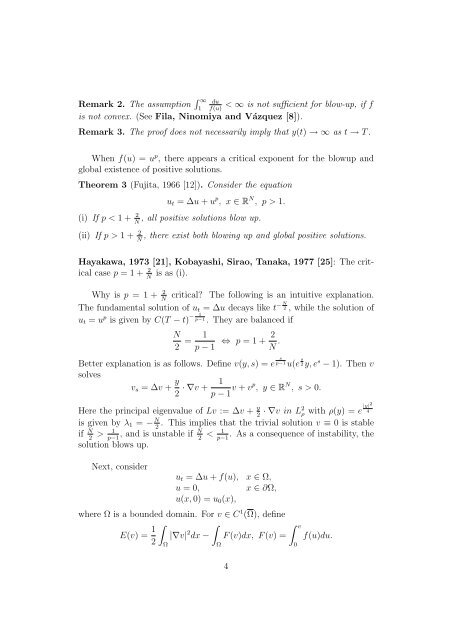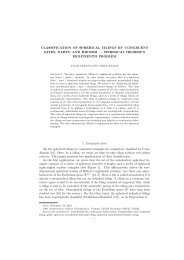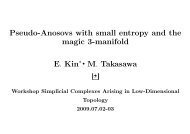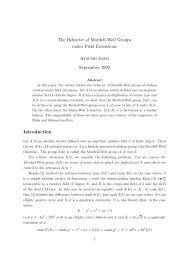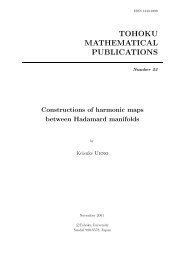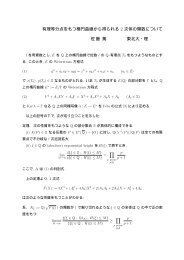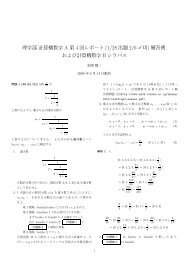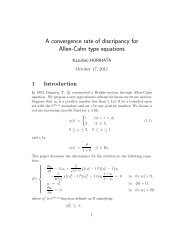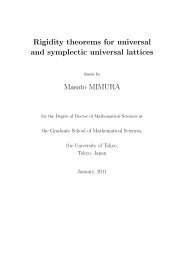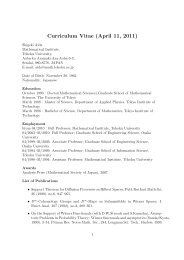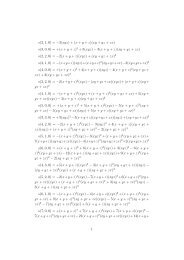Blow-up of Solutions of Semilinear Parabolic Equations
Blow-up of Solutions of Semilinear Parabolic Equations
Blow-up of Solutions of Semilinear Parabolic Equations
You also want an ePaper? Increase the reach of your titles
YUMPU automatically turns print PDFs into web optimized ePapers that Google loves.
Remark 2. The assumption ∫ ∞ du<br />
< ∞ is not sufficient for blow-<strong>up</strong>, if f<br />
1 f(u)<br />
is not convex. (See Fila, Ninomiya and Vázquez [8]).<br />
Remark 3. The pro<strong>of</strong> does not necessarily imply that y(t) → ∞ as t → T .<br />
When f(u) = u p , there appears a critical exponent for the blow<strong>up</strong> and<br />
global existence <strong>of</strong> positive solutions.<br />
Theorem 3 (Fujita, 1966 [12]). Consider the equation<br />
u t = ∆u + u p , x ∈ R N , p > 1.<br />
(i) If p < 1 + 2 , all positive solutions blow <strong>up</strong>.<br />
N<br />
(ii) If p > 1 + 2 , there exist both blowing <strong>up</strong> and global positive solutions.<br />
N<br />
Hayakawa, 1973 [21], Kobayashi, Sirao, Tanaka, 1977 [25]: The critical<br />
case p = 1 + 2 is as (i).<br />
N<br />
Why is p = 1 + 2 critical? The following is an intuitive explanation.<br />
N<br />
The fundamental solution <strong>of</strong> u t = ∆u decays like t − N 2 , while the solution <strong>of</strong><br />
u t = u p is given by C(T − t) − 1<br />
p−1 . They are balanced if<br />
N<br />
2 = 1<br />
p − 1 ⇔ p = 1 + 2 N .<br />
Better explanation is as follows. Define v(y, s) = e s<br />
p−1 u(e<br />
s<br />
2 y, e s − 1). Then v<br />
solves<br />
v s = ∆v + y 2 · ∇v + 1<br />
p − 1 v + vp , y ∈ R N , s > 0.<br />
Here the principal eigenvalue <strong>of</strong> Lv := ∆v + y · ∇v in 2 L2 ρ with ρ(y) = e |y|2<br />
4<br />
is given by λ 1 = − N . This implies that the trivial solution v ≡ 0 is stable<br />
2<br />
if N > 1 , and is unstable if N < 1 . As a consequence <strong>of</strong> instability, the<br />
2 p−1 2 p−1<br />
solution blows <strong>up</strong>.<br />
Next, consider<br />
u t = ∆u + f(u), x ∈ Ω,<br />
u = 0,<br />
x ∈ ∂Ω,<br />
u(x, 0) = u 0 (x),<br />
where Ω is a bounded domain. For v ∈ C 1 (Ω), define<br />
E(v) = 1 ∫<br />
∫<br />
|∇v| 2 dx − F (v)dx, F (v) =<br />
2<br />
Ω<br />
Ω<br />
4<br />
∫ v<br />
0<br />
f(u)du.


